EBR charges a service fee to manufacturers to produce ebike reviews and videos, this began in 2018. It’s the same flat fee for each bike, and it helps us to keep the site going while limiting ad clutter. We appreciate the opportunity to serve you with our opinions and data but respect your right to know that we receive compensation :)
Desiknio is a relatively new electric bike company that’s leveraging proven motor, battery, and controller systems from Ebikemotion Technologies. I got to demo two brand new Desiknio models just a few days after they arrived at a shop in London called Fully Charged, and was told that there will only be 100 or so produced in 2018. There’s a handmade feel to these bikes, you get four color options and three frame sizes… I’m not sure on delivery times, and unfortunately I did not get to see the light options, fender and rack adapter, or the smartphone app. Please chime in with your feedback and corrections! I did my best to record all of the stats (even speaking with the founder of the company for an hour before filming). The Desiknio products are minimalist, sleek, and beautiful, but use premium hardware and command a higher price. I noticed and appreciated the fancy Shimano hydraulic disc brakes, Continental ebike specific tires, Fabric saddle and grips, tapered head tube, 15 mm thru-axle, and quality carbon fiber fork. Thanks to its higher volume gravel-grinder tires and this fork, the bike rides comfortably. There’s only one gear, but the motor helps you zip up to speed and pedaling is near silent. Rather than a chain, this electric bicycle uses a Gates carbon belt drive system and that required a custom frame cutout. Let’s be honest, it’s an expensive single speed with a small motor and limited battery capacity (especially by US standards). The beauty is that it’s fun to pedal even when off, the wires are completely hidden and the display interface almost disappears, and you can double the battery capacity with an optional bottle style pack that mounts to the bosses on the seat tube. For zippy runs around town and easy lifts back upstairs, this bike is a clear winner. However, you will always have to take it up those stairs for a charge, because the battery pack is not easily removable (only for repairs and replacement. The Desiknio Single Speed Urban won me over, but with focus comes compromise.
Driving this e-bike is a compact, 250-watt nominally rated, planetary geared hub motor. It hides perfectly behind the 160 mm disc brake rotor on the left and a slightly larger-than-average 20 tooth sprocket on the right. The rear hangar is floating design, in black of course, and offers a horizontal dropout with stainless steel insert on the right, to manage axle bite as the motor produces force. You can definitely hear the motor when operating at full power with a frame mounted camera, but it fades away when you’re actually just riding. Geared motors, like this one, freewheel efficiently, so you can coast along without any additional drag or resistance… just a bit more weight. I was told that the motor ony weighs ~2.1 kg (4.63 lbs) and there appeared to be enough space for use with a cassette if you wanted to completely change the drivetrain. With both this single speed configuration and the Desiknio Pinion Classic, there’s gap between the right side of the motor casing and the sprocket. I was able to see the 20 small magnets near the sprocket interface, and this is what allows the bike to switch on and off so quickly, and why they opted to skip motor inhibiting brake levers. For an efficient ebike like this, with a 250 watt nominally rated motor, they don’t seem necessary. Especially with such a great sensor and upgraded hydraulic disc brakes. The final upgrade I noticed with this motor is how the power cable was connected. Rather than protruding from the right axle, like most cheaper designs from Bafang and others right now, this one is tucked between the hub casing and disc brake on the left. It adds to the sleek “hidden ebike” nature here, and is going to stay better protected at bike racks and accidents or tips. This bike has no kickstand after all.
Powering this bike is rather small 36 volt 7 amp hour Lithium-ion battery pack that is built right into the downtube. It can slide out the bottom for maintenance or replacement, I believe without removing the bottom bracket crankset (a requirement on the Pinion model), by removing a plastic cap. This battery is a blessing and a curse in my opinion. It offers well below the average 350 watt-hour capacity I see on most electric bikes (many now offer 500+ watt hours) but is completely hidden, positioned low on the frame, and reduces the overall weight of the bike. The reason you probably wouldn’t want a more powerful motor on this bike (aside from European regulations) is that it would drain the pack more quickly and severely limit range. The motor and battery work together perfectly, it’s just designed for pedaling. If you are alright pedaling but struggle with hills, the single speed may not be the right fit. It’s geared for comfortable pedal revolutions around the 25 km/h mark (roughly 15.5 mph) and that’s great for flats and small hills, but not so fun to start. I really think the Pinion 6 or 12 speed give you everything that the Single Speed has, and more, but the price is higher and the weight goes up by ~5 lbs. Both of these electric bikes use batteries with upgraded Panasonic brand cells, I’m told there will be a 250 watt hour external bottle-style battery upgrade (which perhaps could be charged off-bike). And, the charger is relatively basic but compact and lightweight, offering 2 amp output. Do be careful when charging however, because the plugin port is situated between the crank arms and could get snagged and broken. It uses a plastic plug interface that didn’t feel as sturdy as some.
Operating this bike was a bit confusing for me, to be honest. There’s only one button to work with, a circular physical press button on the top tube, near the head tube. Once the bike has battery has been charged, you simply press this button to activate the bike. It seems like the default startup assist level is green (the lowest level) but it could be white (no assist). To cycle through different levels, simply double press the circular button. It goes from green, to yellow, and then red. I did all of my ride testing in red to get a feel for power and noise, but would occasionally see the LED colors change back to green. Could this have been a reference to the battery level? I tried all sorts of press combinations and eventually decided to power of and then on again, in case anything had been messed up. Power the bike off takes ~10 seconds, which is quite a long time in my opinion. Six seconds would be more convenient if your hands are cold or you’re focused on a friend (which was the case during my ride tests). Thankfully, there’s a Bluetooth connected smartphone app with more feedback to draw from. I’m guessing that it shows speed, trip distance, odometer, a more precise battery capacity readout, and possibly a GPS map and user profile. I cannot say however, because that was not available to us at the time of review. One thing that crossed my mind about an app is that you’ll be draining your phone battery with no way to maintain it on the go. It would be nice if there was a USB port somewhere to plug into… even though the main ebike battery is relatively limited on capacity itself. I was told that the bike is compatible with two Supernova LED lights that can be wired-in to run off the battery, but am not sure exactly how that works either. The joys of reviewing a brand new ebike in another country with language barriers!
Desiknio reached out to me via email after posting this review to clarify how the display panel works: press the button for one second to turn the bike on (the system does a diagnostic check on itself and then shows the battery level as white: more than 75%, green: between 50% to 75%, orange: between 25% to 50%, and red: 0% to 25% and blinking faster if 15% or 10%). When you’re ready to change assist levels, just one short click will take you from white: assist off, green: assist 1, orange: assist 2, or red: assist 3. I was told that the bike starts off in level 1, so you get a small level of assist right away. It seems like the assist level color changes after just a few seconds of riding, reverting back to your battery level color (which is why I was seeing green frequently during the ride, despite choosing assist 3 which is red). While adjusting assist levels, a long click of greater than three seconds will turn on and off the lights (if the optional Supernova lights are installed and connected). Once the display reverts back to battery readout, you can hold the button for three more seconds to turn the bike off. Also, you can hold the button for 10 seconds if you want to completely reboot the system (which is what we ended up doing in the video review).
Overall, I really enjoyed this electric bike, especially after comparing it with the Coboc One Soho, a similar looking single speed from a competing brand. This product does not offer cadence and torque sensing, but I prefer the default motor performance and refined power cable interface. This is an electric bike that is fun to ride without assist easy to lift up and store inside (and that’s what I’d probably do given the price and beautiful finish). It would be cool to see a mixte mid-step frame for people who cannot step as high, and I’d probably swap the rigid post with a suspension design for my shoulders, back, and neck. For people who want an active experience, something fast and efficient, an ebike that’s fun to pedal but will still help you manage wind and small hills, this would be a great option. I would absolutely love to see what it looks and rides like with a Lauf carbon suspension fork, and that’s made possible by the tapered head tube and 15 mm thru-axle here. It’s an exciting bike because it’s convenient to ride. There’s a lot less hassle here, except for parking near a power plug and carrying around the charger if you are struggling with range. I wish I had more details for you regarding battery readouts and welcome feedback and questions in the comments below, I’ll do my best to answer. Big thanks to Desiknio for partnering with me on this review and to Fully Charged for hosting me during this visit to London!
Pros:
- Single speed electric bikes tend to be very lightweight and durable, there’s no derailleur hanging down off the rear dropout and no need for shifter mechanisms, the belt drive setup here is even cleaner, tougher, and quieter, it should hold up well at bike racks or if it gets dropped
- The power cable that runs to the motor is tucked in neatly between the disc brake rotor and left side of the hub motor casing, this protects it if the frame tips and will reduce snags as you ride… it’s beautiful and clean, but there is still a quick disconnect for servicing the wheel, tire, and inner tube
- For me, it’s very impressive to see a purpose-built electric bike like this available in three frame sizes, it probably adds to the higher price but is nice considering the frame only comes in high-step
- The frame has smooth welds and is more hand-crafted and refined than a lot of the cheaper e-bikes I test and review, it looks beautiful
- This is one of the lightest electric bikes I have ever reviewed, the large frame only weighs 13.1 kg (28.9 lbs) and is extremely well balanced, perfect for lifting up stairs
- I love that they included bottle cage bosses on the seat tube, and am excited for the expanded energy pack (a bottle style battery with 250 watt hours of additional power to double your range)
- The hydraulic disc brakes stay cleaner and work better than rim brakes, it’s nice that you can adjust the brake lever reach if you’re wearing gloves or have large or small hands
- Ride quality is pretty good here, the tires offer more air volume, the carbon fiber fork dampens vibration, and the saddle was comfortable… but you could always add a 31.6 mm suspension seat post and shockstop stem to soften the bumps
- It surprised me to see a 15 mm thru-axle on the fork vs. a traditional 9.8 mm quick release skewer… this feature, combined with the tapered head tube, means you could swap it out for a suspension fork like the Lauf, which would be awesome :D
- It’s neat that the bike is being produced in four color options, the paint appeared to be very well done, there wasn’t a cheap feel to any part of this bike… even the pedals and reinforced rims were nice
- Note the black rims, black spokes, black motor casing, black fork, and black tubing on the seat post, stem, handlebar, beltring, and cranks… it all looks very nice, and most of the cabling is internally routed to keep the look clean
- It’s neat that Desiknio offers an integrated light package, to keep you visible in nighttime riding conditions, I would consider adding reflective stickers or reflective tires down the road myself (the 6-speed Pinion model did have reflective tires)
- It sounds like there’s an adapter for the rear seat stays, some sort of bridge, that would allow you to mount a proprietary rack and maybe fenders
- I was told that the bike uses CAN BUS communications protocol (like an automobile) which makes diagnosing motor, battery, and controller issues much easier
- The motor utilizes a 20 magnet system with 2 hall sensors for pedal assist, it felt very responsive and fluid to me, almost like a torque sensor at first
- In addition to the Class 1 European 15.5 mph limited model, it sounds like Disiknio will also be releasing a US version that an reach 20 mph for people who prefer to ride a bit faster
- I was told that Desiknio is using 18650 battery cells from Panasonic, which is widely regarded as one of the best manufacturers in terms of quality
- The bike feels stable (I was able to ride with no hands because of the larger tires and fork angle), and the drivetrain just feels solid, nice floating dropouts to tension the belt drive and a stainless steel insert for strength, to handle motor torque
- Bike shops have told me that belt drives can be even more reliable than chains and the Gates carbon belt drive is one of the best, it uses CDX center tracking to stay aligned even if the terrain is bumpy or it gets kicked
Cons:
- You’re paying a lot of money for a relatively small battery pack and minimal motor support, they work well and keep the bike sleek and lightweight… so it depends on what you want, this is a more active electric bike
- Single speed drivetrains rarely derail and reduce wire clutter around the bike and at the handlebar (no shifters needed), but you have to work harder to get the bike started and cannot adjust the pedal cadence once you get up to speed
- I love how simple and clean the interface is, but the circular power button got a bit confusing at times… you press it once to turn the bike on, then double press it to cycle between assist levels (green is low, yellow is medium, and red is high), sometimes it jumped from green to red and other times it went back to white (which is no-assist) and I couldn’t tell how to measure battery capacity, I wish we would have had the app working for this review, I’m sure it adds a lot of feedback
- As cool as it is to have an app, the big downside is that you’ll be running your smartphone with Bluetooth enabled, and this will drain the battery more quickly, there isn’t a USB charging port to tap into anywhere and even if there was, the ebike battery itself is pretty low capacity
- The charger is a bit basic, it offers 2 amp power flow, which is fine for such a small battery here, and connects with a plastic plug just above the bottom bracket, be careful not to snag the wire, you cannot easily remove the battery for charging off bike (just replacements and service) so plan to bring your bike near an outlet all the time… which may be difficult if you’re commuting to work and parking outside
- Without using the smartphone app, you won’t know how far you’ve gone, how fast you’re going, or anything else besides the current level of assist and maybe the battery level (even then, I think the battery readout is going to be very simple compared to a digital percentage readout), the good news is, this bike is easy and fun to ride even if it does run out of juice, I wish that turning it off went a little quicker, it seemed like we had to hold the power button for 10 seconds (which is a long time when it’s cold out), and there wasn’t a tamper prevention mode or key required to operate the bike like most other e-bikes
Resources:
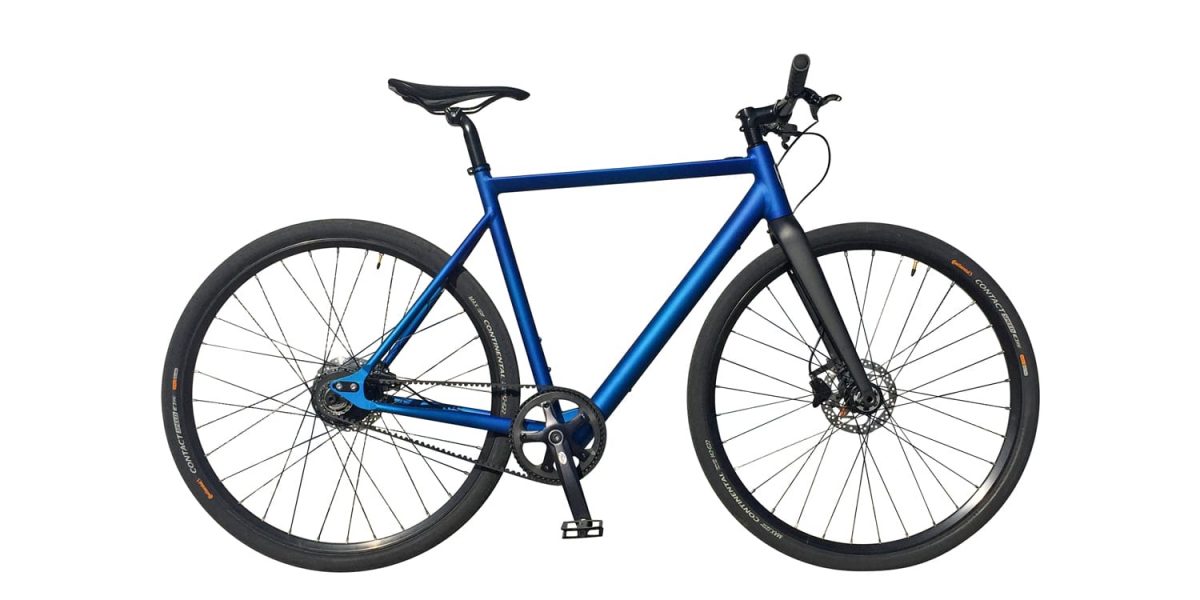








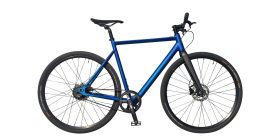

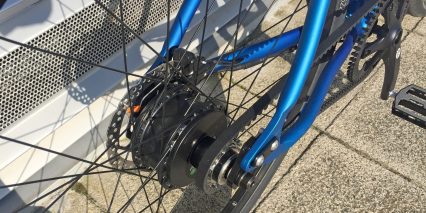
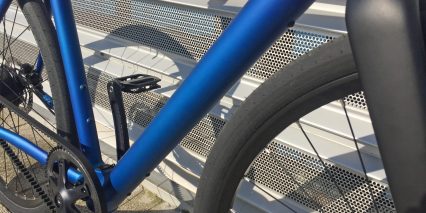
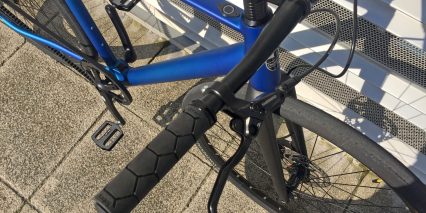
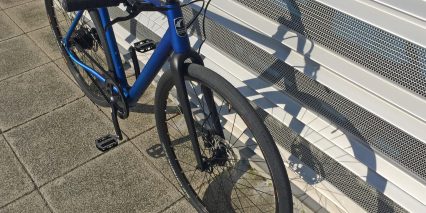
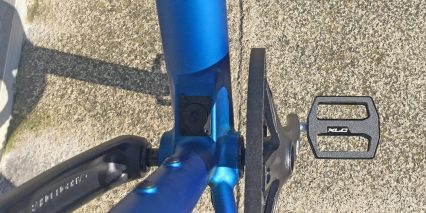
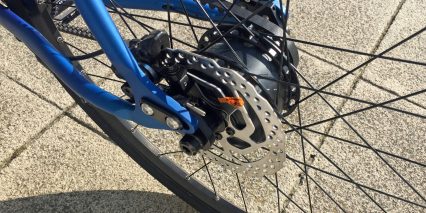
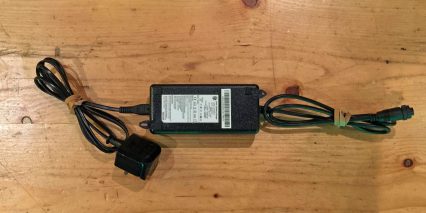

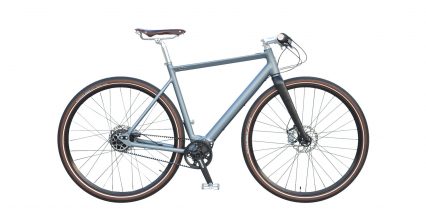
MisterM
7 years agoReally nice minimalist design. The price is extravagant. Yikes!
ReplyCourt Rye
7 years agoYeah, very pricy… It seems like most of the frame-integrated battery bikes cost a lot. Stuff like this, Coboc, and Faraday. Hopefully we will see the price go down with mainstream drive systems like the Ebikemotion Technologies here. I’m surprised it costs that much when they are using a system vs. a custom setup like Faraday.
ReplyJoseph
7 years agoI want to **buy** this bike. I have the Yamaha Giant now. I enjoy the speed and all but I can see the point of a lightweight bike that can go 20mph. Any word on when they are going to release or the US model or How do I buy the current European ??
ReplyCourt Rye
7 years agoHi Joseph, I suggest reaching out to Ben at the Fully Charged shop in London if you’re interested. I believe that he ships Internationally and can adjust speed settings for you. I’d love to hear your thoughts if you do buy one of these, it’s a special bike… I really enjoyed getting to test the Pinion gearbox too, and hope to publish a separate review on that model in the coming weeks ;)
ReplyMichael
7 years agoI have a shortish commute –about 2 miles– but it has a gradient of about 400 ft over the course. Ie, I have a substantial climb in one direction. Given that this is a single speed bike, in terms of rider effort, what kind of performance can I expect on steeper hills? Will it reduce the work only fractionally or will it be substantial?
Replycourt
7 years agoHi Michael! It will reduce the work substantially if you have some speed going in, and can maintain that speed… but if you have to slow down on the hill or stop halfway up, it will help only fractionally and I’d suggest walking it or standing up to pedal. Single speeds and efficient geared hub motors (ie. weaker ones) just don’t offer the sort of climbing performance needed at low speed. It will definitely be easier than a single speed without a motor, and I appreciate that this bike is lightweight and easier to start with (or walk if need be). Desiknio also has a seven-speed option called the Desiknio 6 which has a cool mid-gearbox. I filmed that bike as well and may post the review in the coming week or so if you’d like :)
ReplyGareth Glover
6 years agoI really enjoyed your review. For me the downside is the single indicator button. I much prefer the lights on the crossbar on the Coboc, they look really cool :-)
I’d like to know more about the optional bottle style pack that mounts to the bosses on the seat tube. How do they work? Are the bosses terminals that connect directly to the power and main battery? The optional battery sound like a no-brainer to me considering the limited capacty for the built-in one – given the high sticker price!
ReplyCourt
6 years agoGreat question Gareth… I haven’t been in touch with Desiknio team for quite a while and am currently traveling, on my way to Interbike with limited internet and phone time. They helped me out with this review by coordinating with the Fully Charged ebike shop, but then we got disconnected. Maybe someone else will be able to chime in and help you out with that question about the optional bottle battery? Or perhaps you could ask in the Desiknio forums here. Sorry man, but I’d love to hear back if you do find out!
ReplyGareth
6 years agoI found some info on the Fully Charged website here. The “x35 bottle battery” has a cable at the bottom that connects to the charge port – by ebikemotion. Seems a shame to have a cable floating out the bottom of the bottle battery like that when so much care has been taken to conceal the other cables on the bike that give it such a clean stylish look. The “One Screen” display also looks great, as well as apple watch connectivity… just awesome. A Desiknio Single Speed in dark grey? Hell YES!
ReplyCourt
6 years agoSweet! Thanks for posting these details, and sharing the source Gareth :D
ReplyJeff Mueller
6 years agoI really like the very minimal approach… simplicity, if you will, of this bike. It looks like a bike… very simple, attractive. Kudos for the design and keeping with a simple, attractive style. Great looking bike – great job on the review.
ReplyCourt
6 years agoI agree with you, Jeff. The bikes look beautiful and I had a great time visiting and filming the test rides. I’d love to hear your thoughts if you actually follow through to purchase one :D
Reply